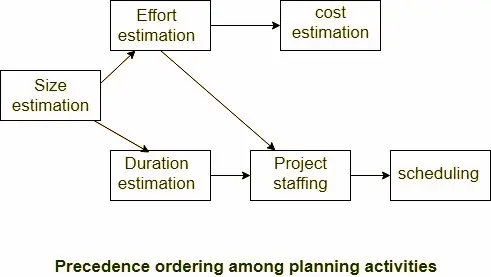Software project planning is an essential part of software engineering that involves the process of creating a detailed project plan for the development of a software product. The purpose of project planning is to define the objectives, scope, requirements, and deliverables of the project, and to establish a clear roadmap for achieving them. The project plan also outlines the tasks, timelines, and resources needed to complete the project, as well as the risks, constraints, and quality standards that need to be considered. Effective project planning is critical to the success of software development projects, as it helps to manage expectations, mitigate risks, and ensure that the project is delivered on time, within budget, and with the desired level of quality.
After determining the feasibility of a project, software project managers embark on project planning, which is completed before the actual development phase. The project planning stage includes several essential activities,
- Project size: This refers to the scope and scale of the project, including the amount of work that needs to be done and the time it will take to complete it.
- Cost: This involves estimating the financial resources that will be required to complete the project, including the cost of labor, materials, and any other expenses that may be incurred.
- Duration: This pertains to the estimated timeline for completing the project, taking into account factors such as resource availability, project scope, and any other relevant constraints.
- Effort: This refers to the level of human effort and resources that will be required to complete the project, including the number of people involved, the amount of time they will need to commit, and the skills and expertise they will need to possess.
Effective planning requires additional designing activities that rely on accurate estimations, including:
- Planning the workforce and allocating alternative resources to ensure that the project is adequately staffed.
- Organizing workers and developing staffing plans that consider the skills, expertise, and experience required for the project.
- Identifying, analyzing, and managing risks that could affect the project’s success, including technical, financial, and operational risks.
- Developing miscellaneous plans like quality assurance, configuration management, and communication plans that help ensure the project’s success.
Arranging the Priority of Project Planning Activities

The ordering of project planning activities is crucial for effective project management. The project manager undertakes various project-related estimations, as mentioned earlier. The following diagram illustrates the sequence in which essential project planning activities should be carried out. It is evident that size estimation is the primary activity and forms the basis for all other planning activities. Estimations like effort, cost, resource, and project length are also critical factors in project planning.
Sliding Window Planning
Effective project planning is critical to the success of any project. It requires careful attention and accurate estimations to avoid schedule delays, client dissatisfaction, and negative impacts on team morale. Failing to properly plan a project can ultimately lead to project failure.
Project planning is a complex and challenging task, especially for large projects where creating accurate plans is difficult. One of the main reasons for this difficulty is the constantly changing parameters such as the project scope, workers, and other factors. To tackle this problem, project managers often use a sliding window planning approach. This approach involves breaking down the project into several stages and planning each stage in a sequential manner. By designing a project in stages, project managers can avoid making significant commitments too early and adjust the plans as the project progresses. This technique of staggered planning is also known as window designing. Project managers can create a more accurate plan for the project by starting with an initial plan and refining it in each successive development stage.
During the start of a project, project managers may not have access to complete information regarding the details of the project. As the project moves through different phases, its information base gradually improves. With the completion of each phase, project managers can plan the subsequent phase with increasing accuracy and confidence.
Hope you have got clarification regarding how Software Project Planning in Software Engineering works. For more useful articles keep following our site @ tutorials.freshersnow.com
